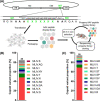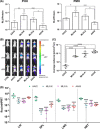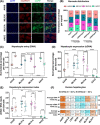Adeno-associated virus serotype 2 capsid variants for improved liver-directed gene therapy
- PMID: 35976053
- PMCID: PMC9936986
- DOI: 10.1002/hep.32733
Adeno-associated virus serotype 2 capsid variants for improved liver-directed gene therapy
Abstract
Background and aims: Current liver-directed gene therapies look for adeno-associated virus (AAV) vectors with improved efficacy. With this background, capsid engineering is explored. Whereas shuffled capsid library screenings have resulted in potent liver targeting variants with one first vector in human clinical trials, modifying natural serotypes by peptide insertion has so far been less successful. Here, we now report on two capsid variants, MLIV.K and MLIV.A, both derived from a high-throughput in vivo AAV peptide display selection screen in mice.
Approach and results: The variants transduce primary murine and human hepatocytes at comparable efficiencies, a valuable feature in clinical development, and show significantly improved liver transduction efficacy, thereby allowing a dose reduction, and outperform parental AAV2 and AAV8 in targeting human hepatocytes in humanized mice. The natural heparan sulfate proteoglycan binding ability is markedly reduced, a feature that correlates with improved hepatocyte transduction. A further property that might contribute to the improved transduction efficacy is the lower capsid melting temperature. Peptide insertion also caused a moderate change in sensitivity to human sera containing anti-AAV2 neutralizing antibodies, revealing the impact of epitopes located at the basis of the AAV capsid protrusions.
Conclusions: In conclusion, MLIV.K and MLIV.A are AAV peptide display variants selected in immunocompetent mice with improved hepatocyte tropism and transduction efficiency. Because these features are maintained across species, MLIV variants provide remarkable potential for translation of therapeutic approaches from mice to men.
Copyright © 2023 The Author(s). Published by Wolters Kluwer Health, Inc. on behalf of American Association for the Study of Liver Diseases.
Conflict of interest statement
Leszek Lisowski owns stock in LogicBio Therapeutics. He received grants from Gyroscope Therapeutics and DiNAQOR. Joachim Schwäble advises BioMarin Pharmaceutical. He received grants from uniQure Biopharma. Hildegard Büning, Nadja Meumann, Joachim Schwäble, and Karin Nien‐Huber are filed as inventors in a patent on MLIV.K and MLIV.A held by Fraunhofer‐Gesellschaft.
Figures







References
-
- ASGCT. Gene, Cell, and RNA Therapy Landscape [Internet]. Q2 2021 Quarterly Data Report. https://asgct.org/global/documents/asgct‐pharma‐intelligence‐quarterly‐r... (2021). Accessed 6 Feb 2022.
-
- Croteau SE, Wang M, Wheeler AP. 2021 clinical trials update: innovations in hemophilia therapy. Am J Hematol. 2021;96:128–44. - PubMed
-
- Rodríguez‐Márquez E, Meumann N, Büning H. Adeno‐associated virus (AAV) capsid engineering in liver‐directed gene therapy. Expert Opin Biol Ther. 2021;21:749–66. - PubMed
-
- Boutin S, Monteilhet V, Veron P, Leborgne C, Benveniste O, Montus MF, et al. . Prevalence of serum IgG and neutralizing factors against adeno‐associated virus (AAV) types 1, 2, 5, 6, 8, and 9 in the healthy population: implications for gene therapy using AAV vectors. Hum Gene Ther. 2010;21:704–12. - PubMed
Publication types
MeSH terms
Substances
Supplementary concepts
LinkOut - more resources
Full Text Sources

